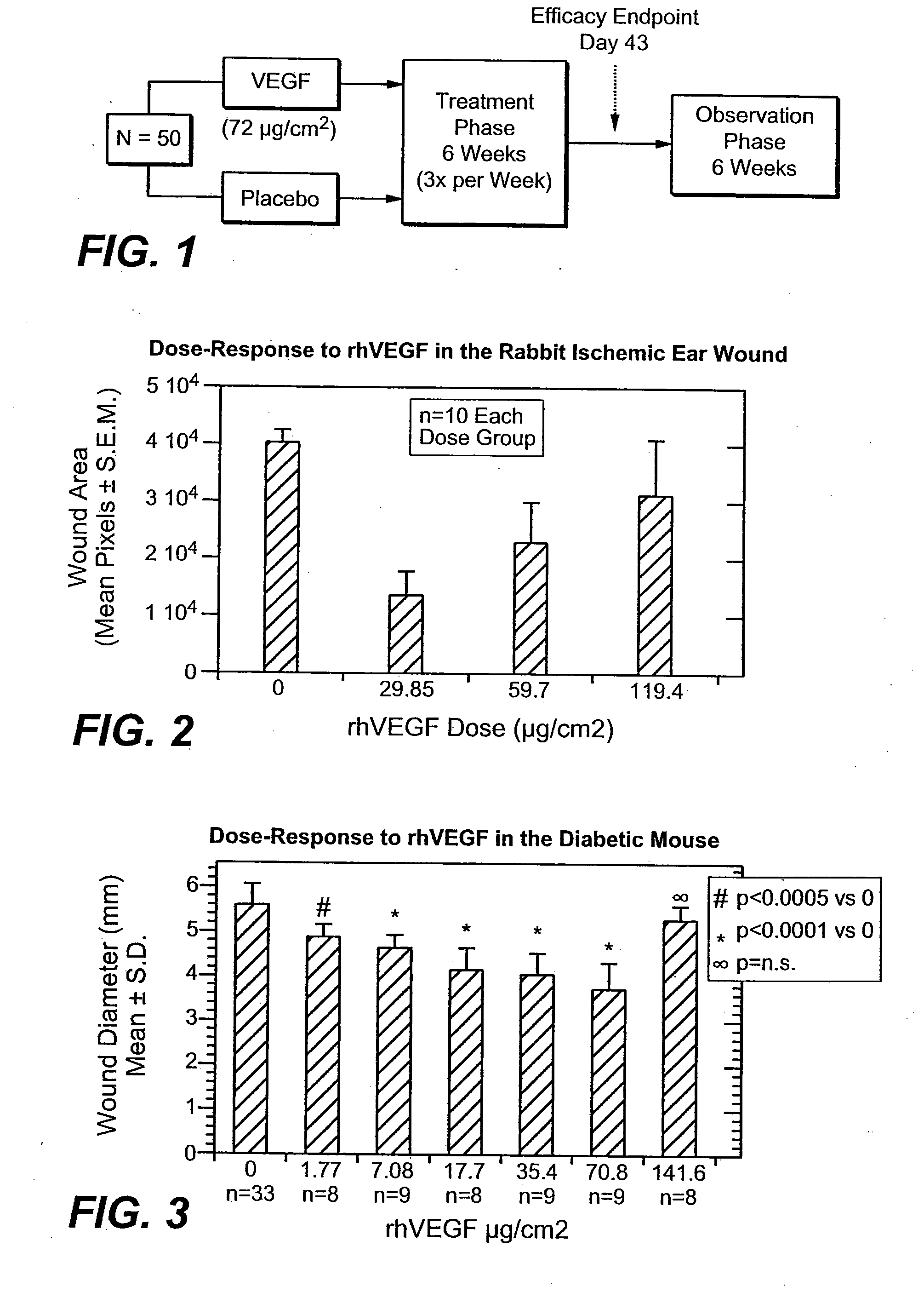Wound Healing
a wound healing and wound technology, applied in the field of wound healing, can solve the problems of affecting the healing effect of wounds, so as to improve wound healing, accelerate wound healing, and reduce the amount of ulcer recurrence.
- Summary
- Abstract
- Description
- Claims
- Application Information
AI Technical Summary
Benefits of technology
Problems solved by technology
Method used
Image
Examples
examples
[0152] It is understood that the examples and embodiments described herein are for illustrative purposes only and that various modifications or changes in light thereof will be suggested to persons skilled in the art and are to be included within the spirit and purview of this application and scope of the appended claims.
[0153] A double-blind (e.g., pharmacist unblinded, MD blinded and patient blinded) clinical trial was performed to determine if application of topical VEGF could promote wound healing in human subjects with diabetic ulcerations. See Table 4 for a chart of baseline disease characteristics of the patients in the study for administering rhVEGF (as referred herein as “Telbermin”) for the treatment of diabetic wounds. The design of the study is indicated in FIG. 1.
TABLE 4Baseline Disease CharacteristicsPlacebo (N = 26)Telbermin (N = 29)Mean Age, y (range)59.3(38-81)59.5(42-74)Mean Glucose, mg / dL225.8(77-465)179.1(29-593)(range)*Mean HbA1C, % (range)†8.4(5.5-13.6)8.3(5...
example 2
EGF in wound healing
[0164] Subjects, e.g., patients with diabetes mellitus I or II, with an estimated ulcer area after sharp debridement of, e.g., ≧1.0 cm2 and ≦6.5 cm2 at the start of treatment, are treated with topical recombinant VEGF (e.g., gel formulation) daily for 12 weeks (for a total of up to 84 doses) total or until complete wound closure (e.g., skin closure without drainage or dressing requirements), which ever comes earlier. Subjects can be observed for 12 weeks or more after the treatment phase. Subjects receive either 24μg / cm2, 72μg / cm2, or 216μg / cm2 VEGF in each daily treatment. The ulcer surface area (cm2) is estimated, e.g., by the length (L(cm)) is the longest edge-to-edge measurement of the ulcer and the width (W(cm)) is taken from a perpendicular axis to the length at the longest edge-to-edge measurement. The estimated surface area is then L×W. Treatment can be assessed by measurement of the perimeter of the ulcer area via tracings, planimetric analysis tracings ...
PUM
| Property | Measurement | Unit |
|---|---|---|
| area | aaaaa | aaaaa |
| area | aaaaa | aaaaa |
| area | aaaaa | aaaaa |
Abstract
Description
Claims
Application Information
 Login to View More
Login to View More - R&D
- Intellectual Property
- Life Sciences
- Materials
- Tech Scout
- Unparalleled Data Quality
- Higher Quality Content
- 60% Fewer Hallucinations
Browse by: Latest US Patents, China's latest patents, Technical Efficacy Thesaurus, Application Domain, Technology Topic, Popular Technical Reports.
© 2025 PatSnap. All rights reserved.Legal|Privacy policy|Modern Slavery Act Transparency Statement|Sitemap|About US| Contact US: help@patsnap.com

